Papers by Elizabeth Sánchez Garay
Brachytherapy, May 1, 2017
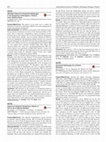
International Journal of Radiation Oncology Biology Physics, Oct 1, 2017
The purpose of our study was to evaluate the utilization of stereotactic radiosurgery (SRS) by ra... more The purpose of our study was to evaluate the utilization of stereotactic radiosurgery (SRS) by race in the management of benign and malignant meningioma. Materials/Methods: The NCDB is a joint project of the American Cancer Society and the Commission on Cancer of the American College of Surgeons, and is a nationwide, comprehensive clinical surveillance resource oncology data set that captures 70% of all newly-diagnosed malignancies in the United States annually. Data for patients meeting the ICD-O-3 criteria for meningioma and undergoing radiation therapy were extracted from the Participant Use File (PUF) 2013 data file encompassing the years 2004 to 2013. Trends of use by race and independent factors related to SRS use were studied. Race categories included White (Wh), Black (Bl), American Indian (AI), Asian (As), and Hawaiian/Polynesian (HP). Statistical analyses were performed on IBM SPSS Statistics version 23.0. Association between SRS use and independent factors was assessed using a general linear model for univariate analysis (UVA), and a linear regression model for multivariate analysis (MVA). Results: A total of 179,498 patients diagnosed with meningioma were identified in the PUF 2013 file. Of these, 17,353 patients underwent RT (56.2% SRS and 43.8% non-SRS). Demographics for this group of patients were: Median age 60, female 70.6%, Wh 83.1%, Bl 13.1%, AI 0.3%, As 3.3%, and HP 0.2%. For patients undergoing SRS, 25.6% of patients were over 70, 95.1% had benign tumors, 70% had tumors <4cm, 80% of patients underwent SRS as monotherapy, and 19.8% of patients underwent combined modality therapy. For the entire population, SRS use increased from 58.
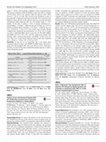
International Journal of Radiation Oncology Biology Physics, Oct 1, 2017
e 68 Gy). 55% of patients completed 50 Gy of prescribed dose. The majority of patients within the... more e 68 Gy). 55% of patients completed 50 Gy of prescribed dose. The majority of patients within the definitive cohort were able to complete 50 Gy (65%), whereas the majority within the adjuvant cohort (58%) received < 50 Gy, pZ0.08. 86% received neck irradiation as part of prescribed RT, of which 82% had bilateral neck RT. 53% of patients in the definitive cohort, and 38% in the adjuvant cohort also received concurrent chemotherapy. Mean follow-up time was 15.9 months (range, 0 e 81.9 months). At the time of analysis, 5 (9%) of patients developed locoregional failure, 3 of which e within the first year of follow-up. 4 (7%) of patients developed distant metastases, 3 of which e within the first two years of follow-up. A total of 20 (34%) deaths were recorded. Median completed dose among the deceased patients was 39 Gy. 55% of deaths were due to underlying H&N cancer. 2-year rates for OS, DSS, LRRFS, and DMFS were 61%, 78%, 93%, and 95%, respectively. Patients with substance abuse, cardiovascular disease, and ECOG 2 had worse survival. There was a trend toward improved survival with total completed dose 50 Gy vs < 50 Gy, 74% vs 44% (pZ0.07) Conclusion: To the best of our knowledge, this is the largest study examining clinical outcomes after PDCRT for H&N tumors. Survival remains poor with incomplete RT, with 2-year OS rate at 61%. Achieving a total dose of at least 50 Gy using standard fractionation appears to confer a relative therapeutic benefit.
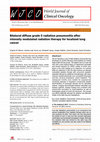
World journal of clinical oncology, 2017
We are reporting a case of fatal radiation pneumonitis that developed six months following chemor... more We are reporting a case of fatal radiation pneumonitis that developed six months following chemoradiation for limited stage small cell lung cancer. The patient was a 67-year-old man with a past medical history of Hashimoto's thyroiditis and remote suspicion for CREST, neither of which were active in the years leading up to treatment. He received 6600 cGy delivered in 200 cGy daily fractions via intensity modulated radiation therapy with concurrent cisplatin/ etoposide followed by additional chemotherapy with dosereduced cisplatin/etoposide and carboplatin/etoposide and then received prophylactic cranial irradiation. The subsequent months were notable for progressively worsening episodes of respiratory compromise despite administration of prolonged steroids and he ultimately expired. Imaging demonstrated bilateral interstitial and airspace opacities. Autopsy findings were consistent with pneumonitis secondary to chemoradiation as well as lymphangitic spread of small cell carcinoma. The process was diffuse bilaterally although his radiation was delivered focally to the right lung and mediastinum.
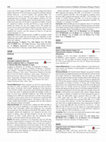
International Journal of Radiation Oncology Biology Physics, Oct 1, 2017
isodose line of 80% (rangeZ63-100%). The most common fractionation regimen reported was 25/5. In ... more isodose line of 80% (rangeZ63-100%). The most common fractionation regimen reported was 25/5. In 474 tumors assessed for radiologic response (median follow-up Z 24.5-57.5 months), 78% remained stable, 18% decreased in size and 4% increased in size. Of 327 patients who were symptomatic prior to treatment, 17% had complete resolution, 41% had improvement, 36% had stability and 6% had deterioration post treatment. Crude local control (LC) was 90-100% as reported in 10 studies. Actuarial LC, reported in 2 studies, was 89% and 92AE3% at 3 years. Overall, the median late toxicity rate was 10% (rangeZ0-21%). The median late toxicity rates for tumors involving the skull base and optic structures were 5% (rangeZ0-21%) and 9% (rangeZ8-10%) respectively. Most common significant late toxicities were new decrease in vision (nZ8) and new cranial neuropathy (nZ11). Conclusion: While the available literature of hSRT for treatment of ICM suggests that local control and toxicity profiles are comparable to other radiotherapy approaches, confirmation in larger patient cohorts with longer follow-up is required.
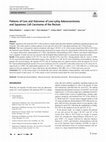
Journal of Clinical Oncology, Feb 1, 2019
Purpose Squamous cell carcinoma (SCC) of the rectum is a unique entity that lacks definitive guid... more Purpose Squamous cell carcinoma (SCC) of the rectum is a unique entity that lacks definitive guidelines regarding prognosis and treatment. This study aimed to analyze patterns of care and survival for SCC and adenocarcinoma (AC) of the rectum. Methods This was a retrospective analysis of patients with stage I-III SCC or AC of the rectum treated from 2004 to 2016 from the National Cancer Database. The treatment groups analyzed were surgery alone (S), chemoradiation followed by surgery (CRT + S), surgery followed by chemoradiation (S + CRT), and definitive chemoradiation (CRT). Patient-and clinical-related factors were compared. Overall survival was assessed with the Kaplan-Meier method and Cox proportional regression models. Results Of the patients studied, 21,587 (97.1%) were AC and 640 (2.9%) were SCC. Among patients with AC, most (n = 8549, 59.4%) received chemoradiation followed by surgery; those with SCC (n = 305, 66.4%) received definitive chemoradiation. Among patients who received surgery, the majority (69.2%) with AC histology had a low anterior resection while the majority (52.1%) of SCC had an abdominoperineal resection. Five-year overall survival of AC versus SCC in the entire cohort was 61.6% versus 56.1%, respectively (p < 0.001). On multivariable analysis for AC, CRT + S (HR 0.61, p < 0.001), or S + CRT (HR 0.67, p < 0.001) had improved survival compared to S alone while those who had definitive CRT (HR 1.55, p < 0.001) had worse survival. Conclusions SCC of the rectum tends to be treated like anal cancers with definitive chemoradiation, with similar survival to historical reports of anal cancer. AC of the rectum is most commonly treated under the rectal cancer paradigm.

International Journal of Radiation Oncology Biology Physics, Nov 1, 2018
anal cancer. We therefore sought to assess for predictors of use of CRT and its impact on overall... more anal cancer. We therefore sought to assess for predictors of use of CRT and its impact on overall survival (OS) in patients with early stage node negative SCC of the anus with favorable characteristics in a large hospitalbased database. Materials/Methods: The National Cancer Database (NCDB) was queried to identify patients who received CRT, defined as initiation of chemo and RT within 14 days of each other, or RT alone (without any chemo during initial treatment phase) for cT1-2N0M0 SCC of the anus. The cohort was limited to patients less than 70 years old with Charlson-Deyo Comorbidity Index of 0. Patients were stratified by age (<60, 60), gender (Male, Female), race (white, black, other), stage (cT1, cT2), facility type (academic, nonacademic), and insurance status (none, private, Medicaid, Medicare, other). Univariable and multivariable logistic regression were performed to assess for predictors of CRT usage. 5-year OS was analyzed using the Kaplan Meier method with the log rank test both for the full cohort and then on the subsets of T1 and T2 patients. Univariable and multivariable logistic regression were used to assess for covariables associated with survival differences. Results: We identified 5,723 patients, of whom 5,425 (94.8%) received CRT and 298 (5.2%) received RT alone. Median follow up was 50.1 months. 68.7% were female and 89.8% were white. There were 33.7% and 66.3% of patients had cT1 and cT2 disease, respectively. Multivariable logistic regression showed patients were less likely to receive CRT if they were of black race (OR 0.448 (0.319-0.631), p<0.0001), and more likely to receive CRT if they had T2 disease (OR 2.199 (1.737-2.784), p<0.0001). Age, facility type, and insurance status were not associated with use of CRT. The 5-year OS was 85.3% overall, 86.0% for CRT and 72.8%% for RT (p<0.0001). For T1 patients, 5-yr OS was 88.4% overall, 89.0% with CRT and 81.5% with RT (pZ0.008). For T2 patients, 5-year OS was 83.8% overall, 84.6% with CRT and 63.9% with RT (p<0.0001). Multivariable Cox regression analysis confirmed association between OS and CRT use, HR 0.508 (95% CI 0.402-0.641, p<0.0001). Conclusion: The vast majority of patients under age 70 without significant comorbidities are treated with chemoradiation over radiation alone for early stage squamous cell carcinoma of the anus, with better survival associated with chemoradiation.
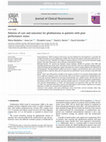
Journal of Clinical Neuroscience, Jun 1, 2018
Purpose/objectives: While treatment with tumor resection followed by chemoradiation is generally ... more Purpose/objectives: While treatment with tumor resection followed by chemoradiation is generally the accepted standard of care for glioblastoma (GBM), the treatment for patients with poor performance status remains uncertain. Therefore we sought to examine patterns of care and survival outcomes among patients with poor performance status utilizing a large hospital database. Methods/materials: We queried the National Cancer Database (NCDB) for patients with GBM and Karnofsky performance status (KPS) <60 between 2010 and 2013. Data was collected regarding surgery, radiation therapy and chemotherapy. Logistic regression was used to analyze predictors for utilization of chemoradiation. The Kaplan-Meier method was used to compare survival between those who received chemoradiation to radiation alone and Cox regression was performed to assess covariates associated with survival. Results: There were 488 patients included in the analysis of which 51.2% received chemoradiation and 46.1% underwent subtotal or gross total resection. None of the factors analyzed were significantly associated with increased likelihood of receiving chemoradiation over radiation alone. Survival data was available for 236 patients that received radiation therapy with and without combination chemotherapy. The median overall survival for those receiving radiation alone was 3.6 months and 8.7 months in those who received chemoradiation (p < 0.001). On multivariable Cox regression, older age (HR 1.80-2.10, p = 0.001) was associated with worse survival and subtotal/gross total resection compared to no surgery (HR 0.60, p = 0.003) was associated with improved survival. Conclusion: Even patients with poor performance status had better survival outcomes when they received treatment with chemoradiation over radiation alone.

Gynecologic Oncology, 2017
To analyze the patterns of care regarding intensity modulated radiation therapy (IMRT) usage in t... more To analyze the patterns of care regarding intensity modulated radiation therapy (IMRT) usage in the postoperative management of uterine cancer. The National Cancer Database was queried to identify women with endometrial adenocarcinoma who underwent hysterectomy followed by external beam radiation between 2004-2012. Descriptive statistics were used to analyze IMRT usage with comparison via the Chi Square test. Overall survival was also compared between IMRT and three dimensional conformal radiation therapy. Multivariable logistic regression and multivariable Cox Regression were used to identify covariables that impact IMRT usage and improved survival respectively. 7839 women were included in this study. IMRT utilization increased from 1.9% in 2004 to 32.4% in 2012 (p&amp;amp;amp;amp;amp;amp;amp;amp;amp;amp;amp;amp;amp;amp;amp;amp;amp;amp;amp;amp;amp;amp;amp;amp;amp;amp;amp;amp;amp;amp;amp;amp;amp;amp;amp;amp;amp;amp;amp;amp;amp;amp;amp;amp;amp;amp;amp;amp;amp;amp;amp;amp;amp;amp;amp;amp;amp;amp;amp;amp;lt;0.001). The adjusted odds ratio (OR) for IMRT in 2012 compared with 2004 was 24.90, 95% CI 15.24-40.67 (p&amp;amp;amp;amp;amp;amp;amp;amp;amp;amp;amp;amp;amp;amp;amp;amp;amp;amp;amp;amp;amp;amp;amp;amp;amp;amp;amp;amp;amp;amp;amp;amp;amp;amp;amp;amp;amp;amp;amp;amp;amp;amp;amp;amp;amp;amp;amp;amp;amp;amp;amp;amp;amp;amp;amp;amp;amp;amp;amp;amp;lt;0.001). Aside from year, other predictors of IMRT usage on multivariate analysis were positive nodes, higher dose, private insurance and higher income. Black race was associated with lower IMRT usage compared to Whites with an OR of 0.60, 95% CI 0.44-0.81 (p=0.001). IMRT was not associated with significantly increased survival (HR 0.86, 95% CI 0.73-1.01, p=0.06). Black race and positive nodes were associated with decreased survival within the group studied whereas private insurance and higher income were associated with improved survival. In this hospital-based registry, IMRT has significantly increased in utilization for postoperative radiation in uterine cancer between 2004-2012 although not resulting in significantly improved survival. Socioeconomic and racial disparities exist in the allocation of IMRT usage.
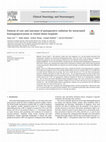
Clinical neurology and neurosurgery, Jan 5, 2018
Several small (<100 patients) studies have been suggestive of a survival benefit associated wi... more Several small (<100 patients) studies have been suggestive of a survival benefit associated with postoperative radiation for intracranial hemangiopericytoma. Given the rarity of this disease, we sought to examine the patterns of care and outcomes of this tumor in the National Cancer Database (NCDB). We accessed the NCDB to identify patients with intracranial hemangiopericytoma between 2004-2012. Patients were categorized by surgical status, postoperative radiation usage, and location (meningeal or brain parenchyma). Multivariable Cox regression was used to identify covariables associated with differences in survival. There were 588 patients included in this study, of which 323 (54.9%) received postoperative radiation. The median age at diagnosis was 51 years and the median follow up was 55.1 months. There were no differences in overall survival between the two groups. The 5-year overall survival was 77.1% for those receiving postoperative radiation and 83.8% for those who did not...
Espéculo: Revista de Estudios Literarios, 1997
Gógol y su legado [Recurso electrónico], 2003, ISBN 970-722-262-X, págs. 125-146, 2003
Los inicios del cine [Recurso electrónico], 2004, ISBN 970-722-264-6, págs. 107-135, 2004
espanolEl objetivo del presente ensayo es mostrar como a traves de una serie de narraciones llama... more espanolEl objetivo del presente ensayo es mostrar como a traves de una serie de narraciones llamadas cosmicomicas, Italo Calvino crea una cosmogonia ironica, sin dioses ni teleologias, que incluye diversos y excepcionales mitos de origen, como la aparicion del deseo, los signos y el lenguaje. EnglishThe purpose of this essay is to present ltalo Calvino's series of short stories Cosmicomics as a means for the creation of an ironical cosmogony, with no gods or teoeologies, which include a variety of extraordinary origin myths such as the birth of desire, signs and language.

Normal.dotm 0 0 1 123 616 CEMARTH 12 1 862 12.0 0 false 21 18 pt 18 pt 0 0 false false false /* S... more Normal.dotm 0 0 1 123 616 CEMARTH 12 1 862 12.0 0 false 21 18 pt 18 pt 0 0 false false false /* Style Definitions */ table.MsoNormalTable {mso-style-name:"Tabla normal"; mso-tstyle-rowband-size:0; mso-tstyle-colband-size:0; mso-style-noshow:yes; mso-style-parent:""; mso-padding-alt:0cm 5.4pt 0cm 5.4pt; mso-para-margin:0cm; mso-para-margin-bottom:.0001pt; mso-pagination:widow-orphan; font-size:12.0pt; font-family:"Times New Roman"; mso-ascii-font-family:Cambria; mso-ascii-theme-font:minor-latin; mso-fareast-font-family:"Times New Roman"; mso-fareast-theme-font:minor-fareast; mso-hansi-font-family:Cambria; mso-hansi-theme-font:minor-latin; mso-bidi-font-family:"Times New Roman"; mso-bidi-theme-font:minor-bidi;} El surgimiento de la dualidad cuerpo/razon en la Modernidad ha conducido a la concepcion del cuerpo humano como una maquinaria que puede ser pulida y mejorada con el fin de potenciar las capacidades racionales del hombre. Esta n...

International Journal of Radiation Oncology*Biology*Physics, 2018
anal cancer. We therefore sought to assess for predictors of use of CRT and its impact on overall... more anal cancer. We therefore sought to assess for predictors of use of CRT and its impact on overall survival (OS) in patients with early stage node negative SCC of the anus with favorable characteristics in a large hospitalbased database. Materials/Methods: The National Cancer Database (NCDB) was queried to identify patients who received CRT, defined as initiation of chemo and RT within 14 days of each other, or RT alone (without any chemo during initial treatment phase) for cT1-2N0M0 SCC of the anus. The cohort was limited to patients less than 70 years old with Charlson-Deyo Comorbidity Index of 0. Patients were stratified by age (<60, 60), gender (Male, Female), race (white, black, other), stage (cT1, cT2), facility type (academic, nonacademic), and insurance status (none, private, Medicaid, Medicare, other). Univariable and multivariable logistic regression were performed to assess for predictors of CRT usage. 5-year OS was analyzed using the Kaplan Meier method with the log rank test both for the full cohort and then on the subsets of T1 and T2 patients. Univariable and multivariable logistic regression were used to assess for covariables associated with survival differences. Results: We identified 5,723 patients, of whom 5,425 (94.8%) received CRT and 298 (5.2%) received RT alone. Median follow up was 50.1 months. 68.7% were female and 89.8% were white. There were 33.7% and 66.3% of patients had cT1 and cT2 disease, respectively. Multivariable logistic regression showed patients were less likely to receive CRT if they were of black race (OR 0.448 (0.319-0.631), p<0.0001), and more likely to receive CRT if they had T2 disease (OR 2.199 (1.737-2.784), p<0.0001). Age, facility type, and insurance status were not associated with use of CRT. The 5-year OS was 85.3% overall, 86.0% for CRT and 72.8%% for RT (p<0.0001). For T1 patients, 5-yr OS was 88.4% overall, 89.0% with CRT and 81.5% with RT (pZ0.008). For T2 patients, 5-year OS was 83.8% overall, 84.6% with CRT and 63.9% with RT (p<0.0001). Multivariable Cox regression analysis confirmed association between OS and CRT use, HR 0.508 (95% CI 0.402-0.641, p<0.0001). Conclusion: The vast majority of patients under age 70 without significant comorbidities are treated with chemoradiation over radiation alone for early stage squamous cell carcinoma of the anus, with better survival associated with chemoradiation.
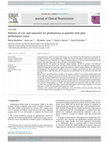
Journal of clinical neuroscience : official journal of the Neurosurgical Society of Australasia, Jan 22, 2018
While treatment with tumor resection followed by chemoradiation is generally the accepted standar... more While treatment with tumor resection followed by chemoradiation is generally the accepted standard of care for glioblastoma (GBM), the treatment for patients with poor performance status remains uncertain. Therefore we sought to examine patterns of care and survival outcomes among patients with poor performance status utilizing a large hospital database. We queried the National Cancer Database (NCDB) for patients with GBM and Karnofsky performance status (KPS) <60 between 2010 and 2013. Data was collected regarding surgery, radiation therapy and chemotherapy. Logistic regression was used to analyze predictors for utilization of chemoradiation. The Kaplan-Meier method was used to compare survival between those who received chemoradiation to radiation alone and Cox regression was performed to assess covariates associated with survival. There were 488 patients included in the analysis of which 51.2% received chemoradiation and 46.1% underwent subtotal or gross total resection. None ...

Neurosurgery, Jan 28, 2017
Although the standard of care for glioblastoma remains maximal safe resection followed by chemora... more Although the standard of care for glioblastoma remains maximal safe resection followed by chemoradiation, conflicting reports have emerged regarding the importance of the time interval between these 2 treatments. To assess whether differences in the duration between surgery and initiation of chemoradiation for glioblastoma had an impact on overall survival (OS) in a large hospital-based database. The National Cancer Database was queried to identify patients diagnosed with glioblastoma between 2010 and 2012 treated with surgery followed by chemoradiation. Patients who received biopsy only were excluded. The time from surgery to initiation of radiation therapy was divided into 4 equal quartiles of ≤24, 25 to 30, 31 to 37, and >37 d. Patient characteristics were compared between groups using Pearson Chi Square and Fisher's Exact test. OS was analyzed via the Kaplan-Meier method and compared via the log-rank test. Univariable and multivariable Cox regression were performed to ass...


Uploads
Papers by Elizabeth Sánchez Garay